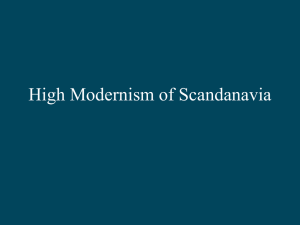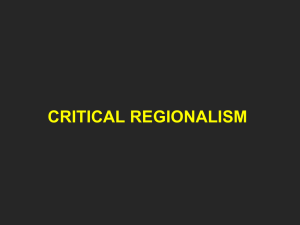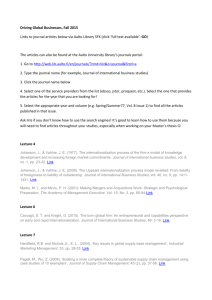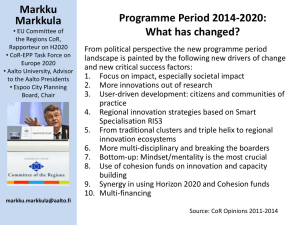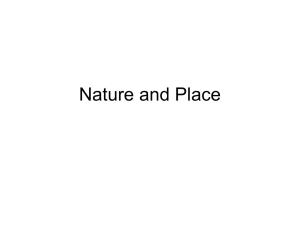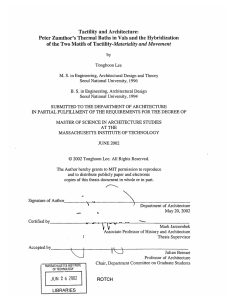the whole essay
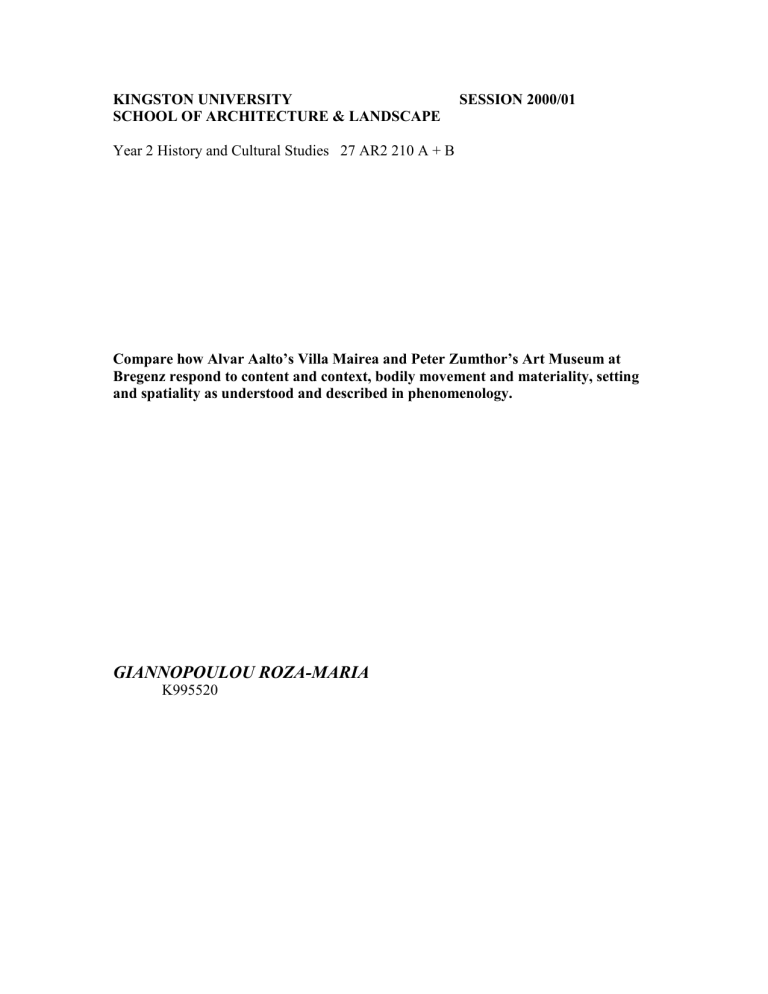
KINGSTON UNIVERSITY SESSION 2000/01
SCHOOL OF ARCHITECTURE & LANDSCAPE
Year 2 History and Cultural Studies 27 AR2 210 A + B
Compare how Alvar Aalto’s Villa Mairea and Peter Zumthor’s Art Museum at
Bregenz respond to content and context, bodily movement and materiality, setting and spatiality as understood and described in phenomenology.
GIANNOPOULOU ROZA-MARIA
K995520
After a series of cultural studies, mainly throughout the 20 th
century, I will concentrate my interest to a quite resent idea of criticizing and perceiving the world, by claim to a universal and absolute truth, Phenomenology, which can be resembled as the culture of every day situations.
Culture can be taken as the deep context of human actions and situations that should be considered in design. Thus, spatial qualities become primary rather than architecture conceived as novel or iconic shape-making, while technology and production becomes subordinate to human ends.
1
Beginning from the presentation of an analytical comparison of the two buildings:
Villa Mairea by Alvar Aalto and Art Museum at Bregenz by Peter Zumthor, and it will be followed by a discussion of a phenomenological approach taking into consideration different views and thoughts.
Content/site & architectural strategies
The Villa Mairea stands in the middle of a pine forest at the top of a hill in western Finland. The house looks mainly as continuous unbroken sketches of forest, with a narrow vista through an opening in the trees on to a river and sawmill.
2
Aalto’s preliminary plans were freely sketched without the use of tools so that the unfettered creative urge for inventive shapes and irregular forms was allowed full play before functional relationships and details were resolved.
His use of complex forms and varied materials, acknowledged the character of the site, and gave attention to every detail of the building.
3
The client asked for an “experimental” house, it is significant that he first envisaged it as a reversion to a vernacular form, and then as variant on a familiar plan
1 Notes, Lecture 1, What is culture?, Kingston University, October 2000
2 Karl Fleig. Alvar Aalto. New York: Praeger Publishers. p175
3 URL: http//:www.AlvarAalto.com
2
type: in embodying a vision of the future Aalto tried to endow the dwelling with strong memories of the past.
4
Memory is the source of poetry. We need memory to produce art and memory is what makes as capable to perceive art along with the word around us. Our perceptive faculties grow quit, unprejudiced and unacquisitive, they reach beyond signs and symbols, they are open, empty. When we look at objects or buildings that seems to be at peace within them selves, our perception becomes calm and dulled. The object we perceive has no message for us, they are simply there. It is as we could see something on which we cannot focus our consciousness. Here, in this perceptual vacuum, a memory surface, a memory which seems to issue from depths of time. Our observation of the object embraces a presentiment of the world in all its wholeness, because there is nothing that cannot be understood. There is a power in the ordinary things of everyday life. 5
This everyday life is encircled from our environment-space ,were “we, as architects, are concerned with space we are concerned with but a tiny part of the infinity that surrounds the earth, each and every building marks a unique place in this infinity” 6 , of our every day life.
Peter Zumthor art museum is sited south of the harbour of lake Constance in
Bregenz, Austria. The project maintains the scale of the existing building and urban fabric. Zumthor chooses to divide the program between two buildings; galleries in one building and service, café, and offices in a smaller building directory south of the galleries. This separation creates a courtyard space with outdoor café seating and establishes as axis to the gallery entrance as well as to the harbour beyond. The project allows circulation from the city to the harbour and adds to the promenade along the waterfront.
7
It is made of glass and steel and a cast concrete stone mass which endows the interior of the building with texture and spatial composition. From the outside, the building looks like a lamp. It absorbs the changing light of the sky, the haze of the lake, it reflects light and colour and gives an intimation of its inner life according to the angle of vision, the daylight and the weather.
Peter Zumthor, Architect
4 Richard Weston, Villa Mairea
5 Peter Zumthor. ‘A way of looking at things’, Architecture and Urbanism. February 1998.
6 Peter Zumthor. ‘A way of looking at things’, Architecture and Urbanism. February 1998.
7 URL:hyyp//:www.zumthor.com
3
Context
Villa Mairea is a traditional timber-sided structure roofed with sod, and built according to the canons of Finnish timber vernacular, in opposition to the sophisticated tectonic of the house itself. .
8
The 'geologically striated' mass of the house and the irregularly contoured perimeter of the sauna plunge pool suggest a metaphorical opposition between artificial and natural form, and this principle of duality obtains throughout the work.
9
The volumes of space created through clustered overlapping of forms were articulated with windows, and introduced views, and motion through curved surfaces.
These curved forms often used by
Aalto, were related to the anthropomorphic forms; he was always concerned with the human factor.
“In his essay on Hebel, Heidegger in fact talks about mans stay “between earth and sky, between joy and pain, between birth and death, between joy and pain, between work and word,” and calls this “multivarious between the world and the “between” of human existence. Each of the four is what it is because it ‘mirrors’ the other.” They all belong together in a “mirror-play” which constitutes the world. The mirror-play may be understood as an open “between,” wherein things appear as they are.
10
Considering the lighting conditions of art Museum at Bregenzhas, that has been designed following the architects initial gesture to make a glowing space not only inside space but also outside space. The exterior of the building acts as lamb. The location of the building creates a reflective environment from the sky and the lake and it also defines the city and the lake by the buildings scale. It is location at the edge of the city next to the lake.
Within the urban Context the Art museum of Bregenz was built as a solitary constraction in a prominent location not far from the lakefront. It fills the space between the Theater for Vorarlberg and the main post office that had been empty for many years.
8 URL: http//: www.villa
Mairea.com
9 Frampton Kenneth. Modern Architecture. A Critical History. Thames and Huston Ltd, London, 1985
10 Christian Norberg –Scuulz. Architecture: meaning and place, Selected essays. Electa/Rizzoli New York,
1988. p42
4
The entrance lies on the eastern side of the building facing the town.The administration building , situated in front of the museum towards the city centre, acts as a transitional structure to the smaller and low building of the old part of the town. All functional facilities of the art museum other than those directly associated with the presentation of art are housed separately in this smaller building, which accommodates a library, the museum shop and a café besides the administrative offices.
The actual exhibition building and the administration building frame an open square, which is closed off on the south by the back wall of the theatre, however opens up on one side towards the city. This square
links the Art
Museum to the city life of Bregenz .
The KUB café puts tables and chairs outside during the warmer seasons so that the square is bustling with café patrons. Often the current exhibition includes open-air events.
The epidermis is only in the most superficial way an indication of where an organism ends and its environment begins.
There are things inside the body that are foreign to it, and there are things outside of it that belong to it….
11
Bodily movement
Villa Mairea represents a conceptual link between the rational-constructivist tradition of the 20th century. The initial sketch for this L-shaped building makes explicit reference to National Romanticism movement.
The basic phase of modern architecture is to give buildings and places individuality, with regard to space and character. This means to take the circumstantial
Peter Zumthor’s design stood out among others because it was the only design to propose a square as an urban area.
11 John Dewey, Art as Experience, Perigee books, New York, 1934, p59
5
conditions of locality and building task into consideration, rather than basing the design upon general types and principles. The new approach become manifest in Alvar Aalto works, who in general wants to adapt the spatial structure of his buildings as well as the surrounding space, and thus he reintroduced topological forms which were hardly admitted by early functionalism. Aalto also aimed at giving his architecture an outspoken local character. Mairea may be considered the first manifestation of the new “regional” approach.
The works of Alvar Aalto are eminently “romantic”, and illustrate how this attitude was able to free modern architecture from the “cosmic” abstraction of early
European modernism. Thus Aalto satisfies Wright’s “hunger for reality”.
12
In the other hand, Zumthor Peter as a contemporary architect believes that architecture today needs to reflect on the tasks and possibilities which are inherently its own. Architecture is not a Vehicle or a symbol for things that do not belong to its essence. In a society, which celebrates the inessential, architecture can put up a resistance, counteract the waste of forms and meanings, and speak its own language. He believes that the language of architecture is not a question of a specific style.
13
Materiality
Aalto’s massive monumental designs both rich in surface textures and traditional materials were showcased with his control of flowing spaces, natural light, sureness of volume and combined with a great attention to detail. He has influenced many through an international style that he so adorned. As he once said,
“nothing is ever reborn, but it never completely disappears either, everything that has ever been emerges in a new form." His belief that buildings should be individual solutions to a given set of problems became the driving force of his architecture, a belief that has become internationally recognized and accepted. in the similarly way Peter Zumthor mention that ‘every building is built for a specific use in a specific place and for a specific society’.
14
In the same way finally, we touch the object and feel the materiality of it and a holle expression of specific meanings, which can only be perceived in just this way in this particular object or architectural context.
In contradiction of Le Corbusier, Aalto said, "Nature not the machine should serve as the model for architecture." This was very much in compliance with the
12 Christian Norberg –Scuulz. Genius Loci, towards a phenomenology of architecture.
Academy Editions
London, 1980. pp195-196
13 Peter Zumthor. ‘A way of looking at things’, Architecture and Urbanism. February 1998.
14 Peter Zumthor. ‘A way of looking at things’, Architecture and Urbanism. February 1998.
6
thoughts of Frank Lloyd Wright. He also marked " Architecture cannot disengage itself from natural and human factors; on the contrary it must never do so. Its function is to bring nature ever closer to us." 15
Concerned to Aalto’s work and style, which is contextual and vernacular, it is presenting sensitivity to contours of the land, angles and direction of the sunlight. He is very conscious of the need for social settings linked directly to natural surroundings with the use of natural landscape.
Moreover, he achieved this through natural living conditions, the use of natural materials, and integration within the boundaries of landscape and vegetation. Nature, sun, trees, and air all served as functions in creating a harmonious balance between natural and artificial.
With a common sense, if looking from outside, the Art Museum reveals itself differently from others by using translucent glass panel to absorb the light and act as a live form.
As Peter Zumthor says “what impresses me about Joseph Beuy s and some of the Arte Povera group, is the precise and sensuous way they use materials. It seems anchored in an ancient, elemental knowledge about mans use of materials, and at the same time to expose the very essence of these materials which is beyond all culturally conveyed meaning.
He believes that if materials are used like this, they can assume a poetic quality in the context of an architectural object, although only if the architect is able to generate a meaningful situation for them, since materials in themselves are not poetic… The sense that he tries to instil into materials is beyond all rules of composition, and their tangibility, “smell and acoustic qualities are merely elements of the language that we are obliged to use”.
16
Something that is well described in the Art museum.
Currently, its matter of different ways of perceiving and treat to a building. It can be an object, conclusion of the use of different mediums (I am therefore I think-
Heidegger), or a subjective idea built from symbolic meanings (I think therefore I am-
Descartes).
From “The Critique of Pure Reason” Kant states that the immediate objects of perception are duepartly to external things and partly to our own perceptive apparatus(dualism). Locke said that secondary qualities (colour, sound, smell, etc.) are subjective and do not belong to the object as it is itself. Kant goes further and says that primary qualities are also subjective. Our sensations do have causes, things-in-themselves that he calls “noumena”. What appears to us in perception, which he calls a
“phenomenon”, consists of two parts: that due to the object (sensation) and that due to our subjective apparatus (the form of the phenomenon). The latter is not itself sensation and therefore not depended upon the accident of environment. We always carry it around with us, and it is a priory in that it is not dependent upon experience. A pure form of sensibility is called a “pure intuition” and there are two such forms, space and time, one for the outer sense, one for the inner.
17
15 URL: http//:www.AlvarAalto.com
16 Peter Zumthor. ‘A way of looking at things’, Architecture and Urbanism. February 1998.
17 Dolibor Vesely. ‘The phenomenology of architecture’. Seminar at the University of Huston, 1984
7
With mind the determinant of truth, man comes to see him self as the hub of reality
18
, WHAT IS THE NATURE OF HUMAN BEINGS BETWEEN THINGS?
Setting/constructions
The Villa Mairea primary spaces, the dining and living rooms, border a sheltered garden court, set within a roughly circular forest clearing.
Similarly, a complex formal operations abound throughout the house: an example is the 'metonymy' of the entrance canopy, the irregular rhythm of its timber screen echoing the irregular spacing of the pine trees in the forest - a device that is repeated in the railing of the interior stair. This is followed, in terms of sequence, by the repetition of the same plan form in the studio, the entry canopy and the plunge pool, all recalling the sinuous perimeter of a typical
Finnish lake. The finishes of the ground floor are also coded as an internal landscape in which changes from tiles to boarding or to rough paving stones denote subtle transformations in mood and status.
We have give thought to the thingness of things to in order to arrive
at a total “vision” of our world. Though such a poetical method we take
“The measure for architecture, the structure of dwelling”
19
Zumthors Art museum relies on a simple, however fundamental structural system to create gallery spaces which rely solely on natural light to illuminate art. The primary structure is comprised of poured in place concrete walls and slabs.
18 T. Granham, ‘A Green Lesson from Metaphysics; Seeing to much wood for the trees’ in Green Shift
Symposium, p6
19 Christian Norberg –Scuulz. Architecture: meaning and place, Selected essays. Electa/Rizzoli New York,
1988. p48
8
Inside the galleries, this concrete structure is fully exposed and responsible for the space. Its simplicity serves to focus all of the attention in the room on the work of art, rather than space itself.
Both Alvar Aalto and Peter Zumthor possessed the visionary power. They were not believers in the usual of the word, but they had in common an acute sense of the quality of things and the ability to translate their understanding into images by means of structure and light
Spatiality/building integrator /lighting
“We must learn to understand that the things themselves are the places and that they do not simply belong to the place,” Secondly the places are embodied by means of
“sculptural forms.” These embodiments are the “characters” which constitute the place.
Sculptural embodiment is therefore the “incarnation of the truth of Being in a work which founds its place.” 20
Villa Mairea expressionistic variations within a modern/organic frame work. The sum is a calmly stunning architectural tone poem, Deeply resonant in a special place and time, earthy and exotic all at once
21
The Kunsthaus Bregenz was conceived as a daylight museum.
The façade made of glass shingles serves as a skin to diffuse daylight that first passes through rows of windows and then through the light ceiling in the halls. Although the light has been refracted three times (glass façade, insulating glasswork, illuminated ceilings), it illuminates the halls differently depending on the time of day or year. In this way, a natural lighting atmosphere is created although the building has no visible windows. Over the hanging light ceiling, specially developed pendulum lamps, controlled by an exterior light sensor on the Kunthaus roof, have been installed that complement the daylight.
20 Christian Norberg –Scuulz. Architecture: meaning and place, Selected essays. Electa/Rizzoli New York,
1988. p46
21 URL: http://www.GreatBuildings.com/buildings/Villa_Mairea.html
9
By separating the enclosure system from the structure, Zumthor invents a strategy to get natural light into the galleries. Each gallery floor is a concrete box with a glass ceiling. These floors are supported by three interior bearing walls allowing them to float above one another in section. The gap created between floors allows natural light pass through the glass enclosure system and down into galleries. This provides natural light in the galleries with ought compromise the wall surface with openings.
After combining two different approaches,of a recognized architect of a the middle century as Alvar Aalto and an accepted contemporary architect as Zumtor Peter, both share similar thoughts based in that ‘wide idea’ of phenomenology.
Heidegger’s clues to a concrete understanding of the term. In his short text “ the
Thinker as Poet “, he ends with few lines which indicate the simple concreteness of the phenomenological approach: “Forests spread/ Brooks plunge/ Rocks persist/ Mist diffuses. Meadows wait/ Springs well/ Winds dwell/ Blessing muses.” 22
22 Christian Norberg –Scuulz. Architecture: meaning and place, Selected essays. Electa/Rizzoli New York,
1988. p14
10
“Our minds are immersed in our body, which is immersed in the word,
Spatiality is understood from the experience of our own body”
11
Every building is built for a specific use in a specific place and for a specific society.
Yes, of course you can and must fly, but it should be with one
foot on the ground - or at least a big toe."
Alvar Aalto
12
Bibliography
1.
Hale, J.A. (2000). Building ideas, an introduction to architectural theory. Wiley
2.
Hegel (1949). The phenomenology of mind. 2 nd
edition
3.
Schulz-Nornberg, C. (1971). New concepts of architecture :Existence, space and architecture. Audio vista London.
4.
Notes, Lecture 1, What is culture?, Kingston University, October 2000
5.
Karl Fleig. Alvar Aalto. New York: Praeger Publishers. p175
6.
URL: http//: www.AlvarAalto.com
7.
Christian Norberg –Scuulz. Architecture: meaning and place , Selected essays.
Electa/Rizzoli New York, 1988. p46
8.
URL: http://www.GreatBuildings.com/buildings/Villa_Mairea.html
9.
Richard Weston, Villa Mairea
10.
Peter Zumthor. ‘A way of looking at things’, Architecture and Urbanism.
February 1998.
11.
URL:hyyp//:www.GreatBuildings.com/buildings/zumthor.com
12.
URL: http//: www.villaMairea.com
13.
Frampton Kenneth. Modern Architecture. A Critical History. Thames and Huston
Ltd, London, 1985
14.
John Dewey, Art as Experience, Perigee books, New York, 1934, p59
15.
Christian Norberg –Scuulz. Genius Loci, towards a phenomenology of architecture. Academy Editions London, 1980. pp195-196
16.
Dolibor Vesely. ‘The phenomenology of architecture’. Seminar at the University of Huston, 1984
17.
T. Granham, ‘A Green Lesson from Metaphysics; Seeing to much wood for the trees’ in Green Shift Symposium, p6
18.
URL: http://www.GreatBuildings.com/buildings/Villa_Mairea.html
13
